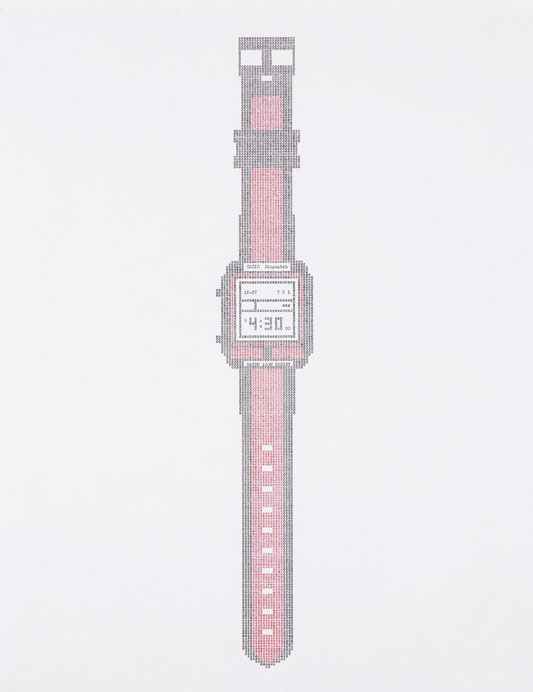« Reviews
Christopher Knowles: In a Word
Institute of Contemporary Art - Philadelphia
Curated by Anthony Elms and Hilton Als.
By Frederick Gross
The poet John Ashbery once called Christopher Knowles’ typed pictographic works “pure Conceptualism,” and this exhibition, co-curated by chief curator Anthony Elms and guest curator Hilton Als, certainly make a case for Knowles’ inclusion among notable artists of the 1970s and ‘80s influenced by Conceptual Art. Knowles’ use of diverse media, such as text, sound, painting, typed images and Lego sculpture is in keeping with similar trends in Neo-Avant-Garde art.
It is refreshing to find a subtle sense of humor in Knowles’ diverse works. In his Map of Manhattan (1975), in which the artist has typed a vertical structure of streets that correspond to the island’s grid, and in shape resemble the slender verticality of the Manhattan Island, the street names become increasingly fantastical, until at the bottom we find Crackler Street, Cracker Street, Ghurapetainan Street and Vibrate Street. Often a repetition of like parts, like typing C’s in different colors to make an image, his works assemble like pieces, such as putting Legos together to make an abstract American flag.

Christopher Knowles, Untitled from the portfolio "Typings," 1986, silkscreen on Ivorite paper, 25 ½” x 19 ¾”. Courtesy the artist.
It seems that Knowles’ work is a form of play by repetition of typographic elements apparently previsualized by the artist. His work brings to mind Oyvind Fahlström’s diagrammatic drawings and collages of the 1960s and Paul Thek’s paintings on newsprint from the 1970s. Concrete poetry, in art history most recently attributed to Carl Andre, is by definition a constructive pattern or shape of linguistic elements in which the typographical shape is more significant in conveying meaning than the letters or words themselves. Its early modernist history begins with Stephane Mallarmé, Guillaume Apollinaire, Gertrude Stein, E. E. Cummings and Ezra Pound. Max Bill and Fahlström coined the term in the early 1950s, and the Brazilian group Noigandres’ manifesto “Pilot Plan for Concrete Poetry” (1958), signed by brothers Augusto and Haroldo de Campos, and Décio Pignatari, drew its modernist history.
To the Noigandres artists, and John Cage, in some of his scores, such as Water Music of 1952, concrete poems were intended to be abstract. An interest in ideograms-and the notion that words themselves could be ideograms-accompanied the typographical innovations developed by these artists. Dan Graham’s “Schema” of 1966 presented a structure that connected to the magazine page and the mass media, cataloguing a list of grammar elements pertaining to the wishes of the editor. Knowles’ contribution as an artist working within the tradition of concrete poetry is to introduce the simple digital image. With Knowles, repetitive C’s become pixels which form geometrical, Pop-related objects such as a watch, a cityscape or space invaders.
Perhaps part of our fascination with this artist is that he seems to be a human computer in an age that is witnessing the shift from humans to computers. His typewriter drawings in scrolls are like dot-matrix printouts. Knowles is the opposite of Pollock or the surrealists in terms of the gestural mark, but his work seeks to order information with a machine in a way that makes cognitive mapping similar; he still desires to access the self, the I, without all of that psychoanalytical pathos. For Knowles, the typed C-pixel replaces the gestural mark or brushstroke in the visual mapping of an image in the artist’s mind.
(September 26 - December 27, 2015)
Dr. Frederick Gross is a professor of art history at the Savannah College of Art and Design.
Filed Under: Reviews



































Leave a Reply
You must be logged in to post a comment.